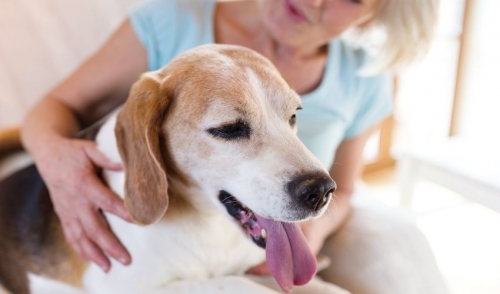
Senior Dog Nutrition
Pets are becoming a greater part of the family with owners willing to invest in their care and their long-term well-being. Advances in veterinary care have also lead to disease prevention, early disease detection and longevity. In general cats live longer than dogs, and small dogs live longer than larger dogs. Cats and small dogs are considered seniors at nine years of age. Medium and large breed dogs are considered seniors at seven years of age and giant breed dogs are seniors by five to six years of age. No matter what breed of pet you have, there are things that we can do to help our pets in their senior years.
Aging is a complex biological and physiological process that is influenced by environment, genetics, and lifestyle choices that can affect degenerative changes in body tissues. While veterinarians can evaluate the overall health of your pet, you are your pet’s best and first ally in health care. You see them every day and are tuned into their personal habits, behavior, and routines. Subtle changes in their habits and routines are the best indication of potential early problems. In addition, look for the following changes as an indication of a potential health problem:
- Changes in weight, especially weight loss
- Decreased appetiteIncrease in water drinking
- Changes in bowel movements (constipation or diarrhea) and urinary routines
- A new cough
- Rapid breathing at rest, difficulty or heavy breathing anytimeNew bumps or lumps
- Difficulty walking, running, climbing stairs, or getting up from a laying down position
- Weakness or collapseFoul mouth odor or drooling
- Seizures, disorientation or confusion
- Changes in sleep pattern or personality
Many owners interpret some of these as normal signs of aging and diminish their significance until it may be too late to help. Any changes should be reported to your veterinarian so that medical problems can be diagnosed and treated. In addition, changes in vision, hearing and agility can lead to decreased comfort and safety issues at home. Consider the following for your aging pet:
- Older pets can have an especially difficult time seeing in the dark. Consider using photocell activated nightlights strategically placed throughout the house to help your cat or dog see at night.
- Use carpet or non-slip treads on the stairs for greater traction to prevent slipping and falling.
- For very arthritic dogs use a Help `Em Up HarnessTM or a towel when they need to go up and down the stairs. This will give the support they need and prevent an accident.
- During the day, when you are at work, block the stairs with a baby gate for your dog’s safety.
- Attach plastic netting around balcony and stair railing posts so cats and small dogs with balance or visual issues do not fall through them.
- Use a ramp or portable stairs to help dogs in and out of the car or onto the bed, if they are accustomed to sleeping with you.Use padded dog and cat beds such as those made with memory foam to gently support stiff, arthritic joints.
- Older dogs with significant visual deficits or episodes of confusion should always go outdoors on a leash or be confined to an enclosed space so they do not wander off and get lost.
- Older cats with arthritis, confusion and early dementia or visual impairment should always be kept indoors for their own safety.
Keep all of this information in mind for your older pet so they can enjoy their senior years.
The feed room is proudly brought to you by Nutrena and Cargill Animal Nutrition. Learn more about us here. You can see the original blog post here.
